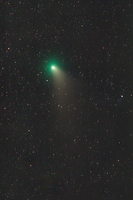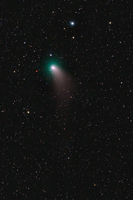|
2023 February 08:
photographed
against the stars of Auriga when about magnitude 6, but low in altitude
from southern Australia.
Canon 5D II + 500mm lens, on an NEQ6 Pro mount tracking the sky. A series of thirty six 45 sec exposures (~27 mins total) at f5 and ISO 2500 were aligned on the comet, while eight of the images (6 mins total) were separately aligned on the stars. These were combined to optimise the comet against the star field; field of view 4.1° x 2.8°, north is to the right. |
|
|
2023 February 19: about magnitude
6 photographed against the stars of Taurus at a much more favourable
altitude.
Takahashi TOA-130, fl=1000mm, f7.7 + SBIG STL11000M camera on a Takahashi EM-200 Temma2 mount tracking the sky. A series of seven R:G:B filtered frames each 180 secs long were separately aligned on the comet and on the stars. These were combined to optimise the comet against the stars; field of view 2.1° x 1.4°, north is to the right. |
|
| 2023
February 20: about magnitude
6 photographed against the stars of Taurus.
Takahashi TOA-130, fl=1000mm, f7.7 + SBIG STL11000M camera on a Takahashi EM-200 Temma2 mount tracking the sky. A series of seven R:G:B filtered frames each 180 secs long were separately aligned on the comet and on the stars. These were combined to optimise the comet against the stars; field of view 2.1° x 1.4°, north is to the right. |
-web-tn.jpg)

